15 Intermediate Guitar Chords You Must Learn
Great Voicings To Play More Complex Songs
If you’re an intermediate guitar player and you’re looking to add some new chords to your repertoire, then you’re in the right place.
There are more chords than just the few that you started with - MANY more!
We’re going to concentrate on several more that will allow you to play more complex songs.
These chords are voiced differently than the few that you previously learned.
These different voicings can add different sounds to songs.
They are much like minor chords that you learned in the beginning - they can carry a different “mood” and help the song go in a new direction.
You will also be able to experiment with different chord progressions using these new chords.
You will be learning:
- Suspended (“sus”) chord structure
- Minor 7th chord structure
- Major 7th chord structure
- Dominant 7th chord structure
- Chords where the root note is not always located on the lowest string (ex. G Major/B)
- Some simple barre chords which require multiple notes to be pressed down with one finger.
Some of these structures can be played in multiple places up the neck.
Here are 15 chords for the intermediate guitarist.
Get your fingers stretched and let’s check them out!
15 Intermediate Guitar Chords
A sus 2

To play A sus 2, you will use your index and middle fingers.
- Mute the low E string.
- Play the A string open.
- Place your index finger (1) on the 2nd fret of the D string.
- Place your middle finger (2) on the 2nd fret of the G string.
- Play the B string open.
- Play the high E string open.
A sus 4
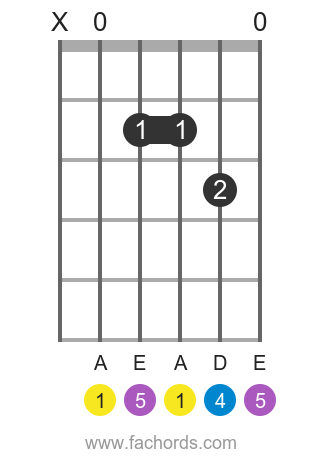
To play A sus 4, you will use your index, middle, and pinkie.
- Mute the low E string.
- Play the A string open.
- Place your index finger (1) on the 2nd fret of the D string.
- Place your middle finger (2) on the 2nd fret of the G string.
- Place your pinkie (4) on the 4th fret of the B string.
- Play the high E string open.
A Major 7
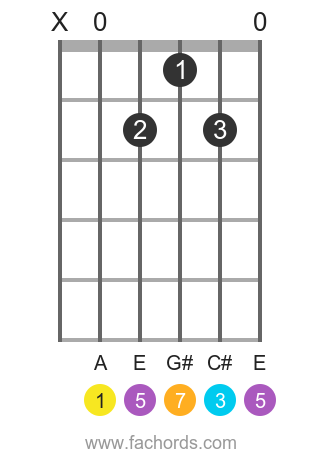
To play A Major 7, you will use your index, middle, and ring fingers.
- Mute the low E string.
- Play the A string open.
- Place your middle finger (2) on the 2nd fret of the D string.
- Place your index finger (1) on the 1st fret of the G string.
- Place your ring finger on the 2nd fret (3) of the B string.
- Play the high E string open.
A Major/C#

This one is a little tricky since it involves using the index finger to press down on the D string, G string, and B strings at the 2nd fret at the same time (barring), and at the same time you should mute high E string.
It also uses the pinkie to reach over and press down on the 4th fret of the A string.
To play A Major/C#, you will use your index and pinkie fingers.
- Mute the low E string.
- Barre the D string, G string, and B string by placing your index finger (1) on the second fret of each string at the same time.
- Place your pinkie (4) on the 4th fret of the A string.
- Mute the low E string.
D sus 2
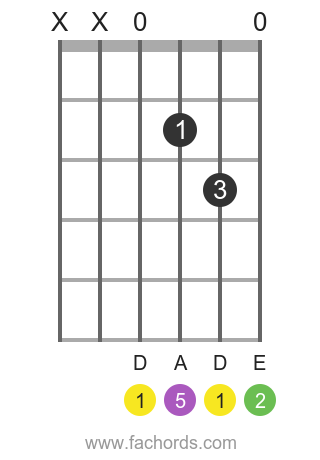
To play D sus 2, you will use your index and ring fingers.
- Mute the top 2 strings (low E and A).
- Play the D string open.
- Place your index (1) finger on the 2nd fret of the G string.
- Place your ring finger (3) on the 2nd fret of the B string.
- Play the high E string open.
D sus 4

To play D sus 4, you will use your index, ring, and pinkie fingers
- Mute the top 2 strings (low E and A).
- Play the D string open.
- Place your index finger (1) on the 2nd fret of the G string.
- Place your ring finger (3) on the 3rd fret of the B string.
- Place your pinkie (4) on the 3rd fret of the high E string.
D Major 7
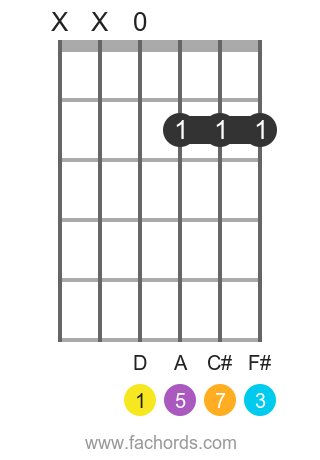
To play D Major 7, you will only need to use your index finger.
- Mute the top 2 strings (low E and A).
- Play the D string open.
- Barre the D string, G string, and B string by placing your index finger (1) on the second fret of each string at the same time.
D Minor 7
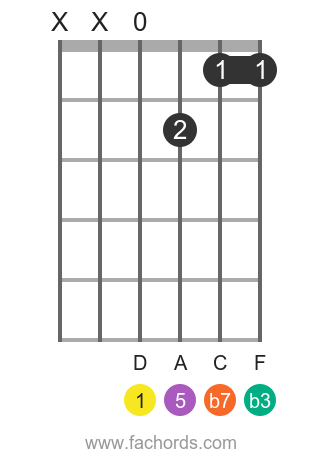
To play D Minor 7, you will use your index, middle, and ring fingers.
- Mute the top 2 strings (low E and A).
- Play the D string open.
- Place your ring finger (3) on the 2nd fret of the G string.
- Place your index finger (1) on the 1st fret of the B string.
- Place your middle finger (2) on the 1st fret of the high E string.
D6
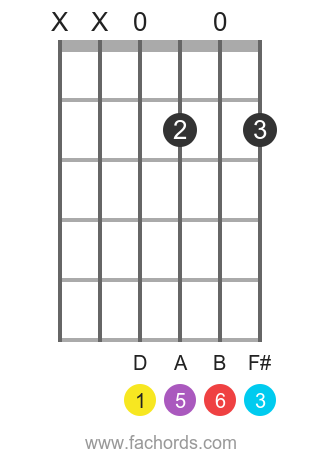
To play D6, you will use your middle finger and ring finger.
- Mute the top 2 strings (low E and A).
- Play the D string open.
- Place your middle finger (2) on the 2nd fret of the D string.
- Play the B string open.
- Place your ring finger (3) on the 2nd fret of the high E string.
D5

This is also called a power chord since it uses only 2 notes in its structure. You will use your index and ring fingers.
- Mute the top 2 strings (low E and A).
- Play the D string open.
- Place your index finger (1) on the 2nd fret of the G string.
- Place your ring finger (3) on the 3rd fret of the B string.
- Mute the high E string.
C Minor 9

You will use your index, middle, ring, and pinkie fingers to play C Minor 9.
- Mute the low E string.
- Place your middle finger (2) on the 3rd fret of the A string.
- Place your index finger (1) on the 1st fret of the D string.
- Place your ring finger (3) on the 3rd fret of the G string.
- Place your pinkie finger (4) on the 3rd fret of the B string.
- Mute the high E string.
C9
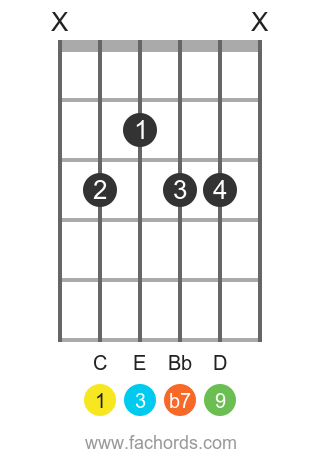
You will use your index, middle, ring, and pinkie fingers to play C9.
- Mute the low E string.
- Place your middle finger (2) on the 3rd fret of the A string.
- Place your index finger (1) on the 2nd fret of the D string.
- Place your ring finger (3) on the 3rd fret of the G string.
- Place your pinkie (4) on the 3rd fret of the B string.
- Mute the high E string.
G Major/B
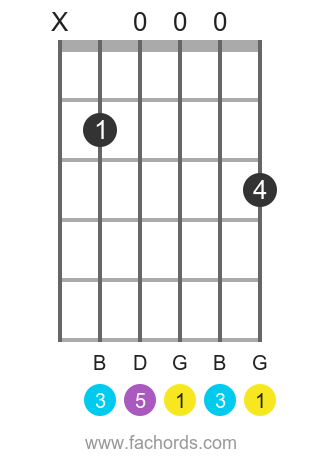
You will use your index finger and pinkie finger to play G Major/B.
- Mute the low E string.
- Place your index finger (2) on the 2nd fret of the A string.
- Play the D string open.
- Play the G string open.
- Play the B string open.
- Place your pinkie (4) on the 3rd fret of the high E string.
G Major 7
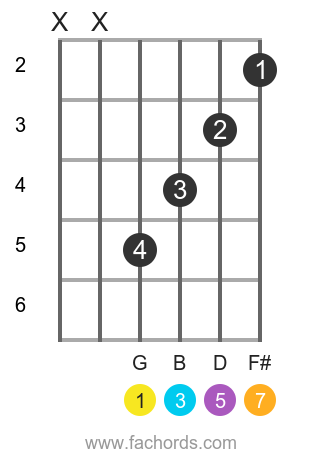
You will use your index, middle, ring, and pinkie to play G Major 7.
- Place your index finger (1) on the 3rd fret of the low E string.
- Mute the A string.
- Place your ring finger (3) on the 4th fret of the D string.
- Place your pinkie (4) on the 4th fret of the G string.
- Place your middle finger (2) on the 3rd fret of the B string.
- Mute the high E string.
G Minor 7
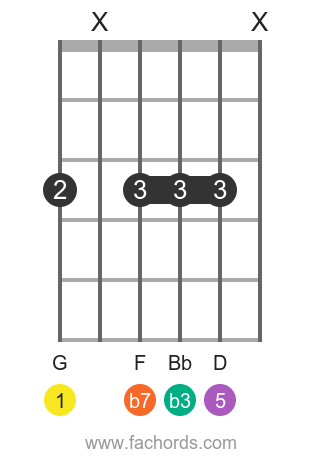
You will use your index, middle, ring, and pinkie fingers to play G Minor 7.
- Place your index finger (1) on the 3rd fret of the low E string.
- Mute the A string.
- Place your middle finger (2) on the 3rd fret of the D string.
- Place your ring finger (3) on the 3rd fret of the G string.
- Place your pinkie finger (4) on the 3rd fret of the B string.
- Mute the high E string.
Tips for Playing Guitar Chords
Some chords require you to press down on more than one string at a time with the same finger.
This will take practice to execute them cleanly. Don’t get discouraged!
Always stretch your hands and wrists before you practice.
Doing this will prevent strain or injury on some of the more difficult chords.
Try to find a song or a passage that uses some of these chords so that you can get a feel for how they are supposed to sound.
Some chord structures can be moved up and down the neck to achieve different root notes.
For example, a G Minor 7 chord can be played at the 5th fret to achieve an A Minor 7.
Certain genres of music will use certain chord structures more often than other styles.
Try not to rely on a chord diagram. Learn (not memorize) these chords so that you can switch between them fluidly with little difficulty.
Conclusion on Intermediate Guitar Chords
Intermediate guitar players have plenty of chords to keep them busy.
This list could be much longer, but these chords are great ways to introduce you to some basic barre chords as well as some different chord voicings like 7th, 9th, and suspended.
They are a bit more difficult than some of the beginner chords.
This is not only because they require a little more dexterity to perform, but they are also voiced differently than basic major and minor chords - meaning that they sometimes don’t sound “right”.
The main thing to remember is to not give up.
Accept the challenge, and realize that the guitar can be one of the most difficult instruments in the world to play even though it is a common instrument.
FAQ
What Should You Learn As Intermediate Guitar Player?
You should begin learning 7th, 9th, and other chord voicings that may not sound quite right to your ear like major and minor chords do.
Intermediate players should also begin to learn some basic barre chord shapes in order to prepare them for more difficult chords in the future.
I also like to teach my students a little music theory at this point as well.
You don’t have to go in-depth with it, but it can help train your brain for more challenging chords and scales later on.
It’s also wise to apply a consistent guitar practice routine to your schedule. That’s how you will make progress fast!
Is Learning Guitar Chords a Must for Intermediate Guitarist?
Yes. I believe that learning chords is a fundamental element in guitar playing.
It will make you a better guitarist in the long run.
When Intermediate Guitar Player Should Move to Learning Advanced Guitar Chords?
An intermediate guitar player should move on to more advanced chord structures when they are able to switch between chords fluidly with little difficulty.
They should also be able to identify songs that use some of these intermediate chords so that they have a clear understanding of how they can be used.
That's all! To stay updated, please subscribe here for free.